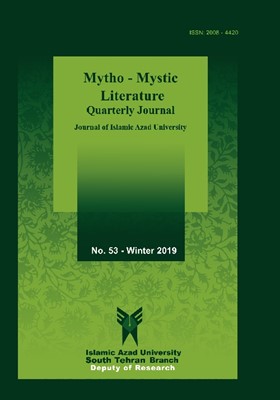-
-
List of Articles
-
Open Access Article
1 - The Myths of Siavash and Kotan Utunnai: A Comparative Study in Persian and Far East Mythologies; Based on Joseph Campbell's Approach
Saeed Akhavāni Fattāneh Mahmoudi -
Open Access Article
2 - Some Mythical Elements in Homāy o Homāyun
Monā Ahmadi Ahmad Khātami -
Open Access Article
3 - Unity of Binary Oppositions in Ilāhī-Nāmeh; Based on the Concepts of Transformation and Equation
Sabikeh Esfandiyār Mahmood Hasanābādi Maryam Shabānzādeh -
Open Access Article
4 - The Methods of Healing (as a Karāmat) in the Mystical Prose Texts
Maryam Haghi -
Open Access Article
5 - Cane and Its Role in Myths and Religions
Ali Heidary Mohammadrezā Hasani Jaliliān Ali Noori Maryam Yārahmadi -
Open Access Article
6 - Two New Readings of the Mythological Narratives Based on Henri Corbin's Shiite Reading
Vidā Dastmālchī -
Open Access Article
7 - The Relationship between Autocracy and Freedom in a Political Myth: Sophocles' Antigone
Parichehreh Shāhsavan Bagdādi Hāmed Amouee Elhām Hosseinkhāni -
Open Access Article
8 - The Capacities and Constraints of Using Myths in Novels of the Imposed War of Iraq against Iran
Mohammad Alijāni Mohammad Āhi -
Open Access Article
9 - The Archetype of Circle: Symbols and Functions
Amir Hossein Madani -
Open Access Article
10 - The Mystical Interpretation of Qor’ānic verses in Tamhīdāt
Narjes Khātoon Mirzāee Leilā Nouroozpour
-
The rights to this website are owned by the Raimag Press Management System.
Copyright © 2021-2025







